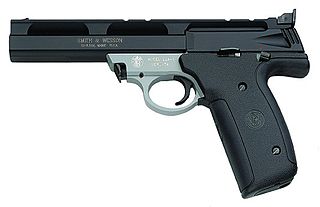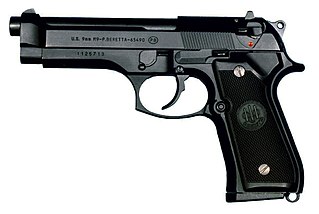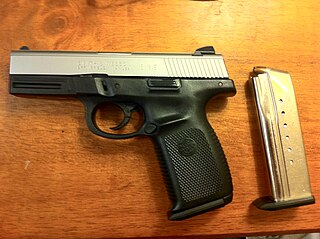
A revolver is a repeating handgun that has at least one barrel and uses a revolving cylinder containing multiple chambers for firing. Because most revolver models hold up to six cartridges before needing to be reloaded, revolvers are also commonly called six shooters.

Smith & Wesson Brands, Inc. (S&W) is an American firearm manufacturer headquartered in Springfield, Massachusetts, United States.

The .40 S&W is a rimless pistol cartridge developed jointly by American firearms manufacturers Smith & Wesson and Winchester in 1990. The .40 S&W was developed as a law enforcement cartridge designed to duplicate performance of the Federal Bureau of Investigation's (FBI) reduced-velocity 10mm Auto cartridge which could be retrofitted into medium-frame semi-automatic handguns. It uses 0.40-inch (10 mm) diameter bullets ranging in weight from 105 to 200 grains.

The Smith & Wesson Model 22A is a semi-automatic pistol that was manufactured in Houlton, Maine. The 22A is a full-size pistol with an aluminum alloy frame. The steel barrel has an integrated Weaver style rail.

The Smith & Wesson 5906 is a pistol manufactured starting in 1988 by Smith & Wesson.

The Smith & Wesson Model 10, previously known as the Smith & Wesson .38 Hand Ejector Model of 1899, the Smith & Wesson Military & Police or the Smith & Wesson Victory Model, is a K-frame revolver of worldwide popularity. In production since 1899, the Model 10 is a six-shot, .38 Special, double-action revolver with fixed sights. Over its long production run it has been available with barrel lengths of 2 in (51 mm), 3 in (76 mm), 4 in (100 mm), 5 in (130 mm), and 6 in (150 mm). Barrels of 2.5 inches (64 mm) are also known to have been made for special contracts. Some 6,000,000 of the type have been produced over the years, making it the most produced handgun of the 20th century.

The M1917 Revolvers were six-shot, .45 ACP, large frame revolvers adopted by the United States Military in 1917, to supplement the standard M1911 pistol during World War I. There were two variations of the M1917, one made by Colt and the other by Smith & Wesson. They used moon-clips to hold the cartridges in position, facilitate reloading, and to aid in extraction since revolvers had been designed to eject rimmed cartridges and .45 ACP rounds were rimless for use with the magazine-fed M1911. After World War I, they gained a strong following among civilian shooters. A commercial rimmed cartridge, the .45 Auto Rim, was also developed, so M1917 revolvers could eject cartridge cases without using moon-clips.

In American English, a pocket pistol is any small, pocket-sized semi-automatic pistol, and is suitable for concealed carry in a pocket or similar space.

The Joint Service Small Arms Program, abbreviated JSSAP, was created to coordinate weapon standardization between the various United States armed service branches.

The S&W Model 4006 is a semi-automatic handgun introduced by Smith & Wesson on January 17, 1990 along with the new .40 S&W cartridge. It is a 3rd-generation S&W pistol.

The Smith & Wesson Model 59 is a double-action pistol produced from 1971 to 1982. It was developed by Smith & Wesson from the earlier Smith & Wesson Model 39 by adapting a 14-round capacity stagger-stack magazine.

The Smith & Wesson M&P is a polymer-framed, short recoil operated, locked breech semi-automatic pistol introduced in the summer of 2005 by the American company Smith & Wesson. It uses a Browning-type locking system. While targeted at law enforcement agencies, the M&P is also widely available on the commercial market.

A handgun is a firearm designed to be usable with only one hand. It is distinguished from a long gun which needs to be held by both hands and braced against the shoulder. The two most common types of handguns are revolvers and semi-automatic pistols, although other types such as derringers and machine pistols also see infrequent usage.

The Smith & Wesson Sigma, was Smith & Wesson's first venture into using synthetic materials in pistol construction, using high-strength polymer material for the frame. The pistol is similar to a Glock safe-action pistol in both its design and operation, leading to controversy and speculation regarding the pistol's patents' legality.

The Volcanic Repeating Arms Company was an American company formed in 1855 by partners Horace Smith and Daniel B. Wesson to develop Walter Hunt's Rocket Ball ammunition and lever action mechanism. Volcanic made an improved version of the Rocket Ball ammunition, and a carbine and pistol version of the lever action gun to fire it. While the Volcanic Repeating Arms Company was short-lived, its descendants, Winchester Repeating Arms Company and Smith & Wesson became major firearms manufactures.

The Smith & Wesson Model 41 is a semi-automatic pistol developed by Smith & Wesson after World War II as a competitive target pistol. It was designed with a 105 degree grip angle, the same as the Colt M1911 pistol, to maintain a consistent grip angle.

The Smith & Wesson Bodyguard 380 is a compact semi-automatic pistol produced by Smith & Wesson chambered for the .380 ACP cartridge.

The Smith & Wesson SD VE is a polymer-framed, striker-fired semi-automatic pistol series that the American company Smith & Wesson introduced in 2012.


















